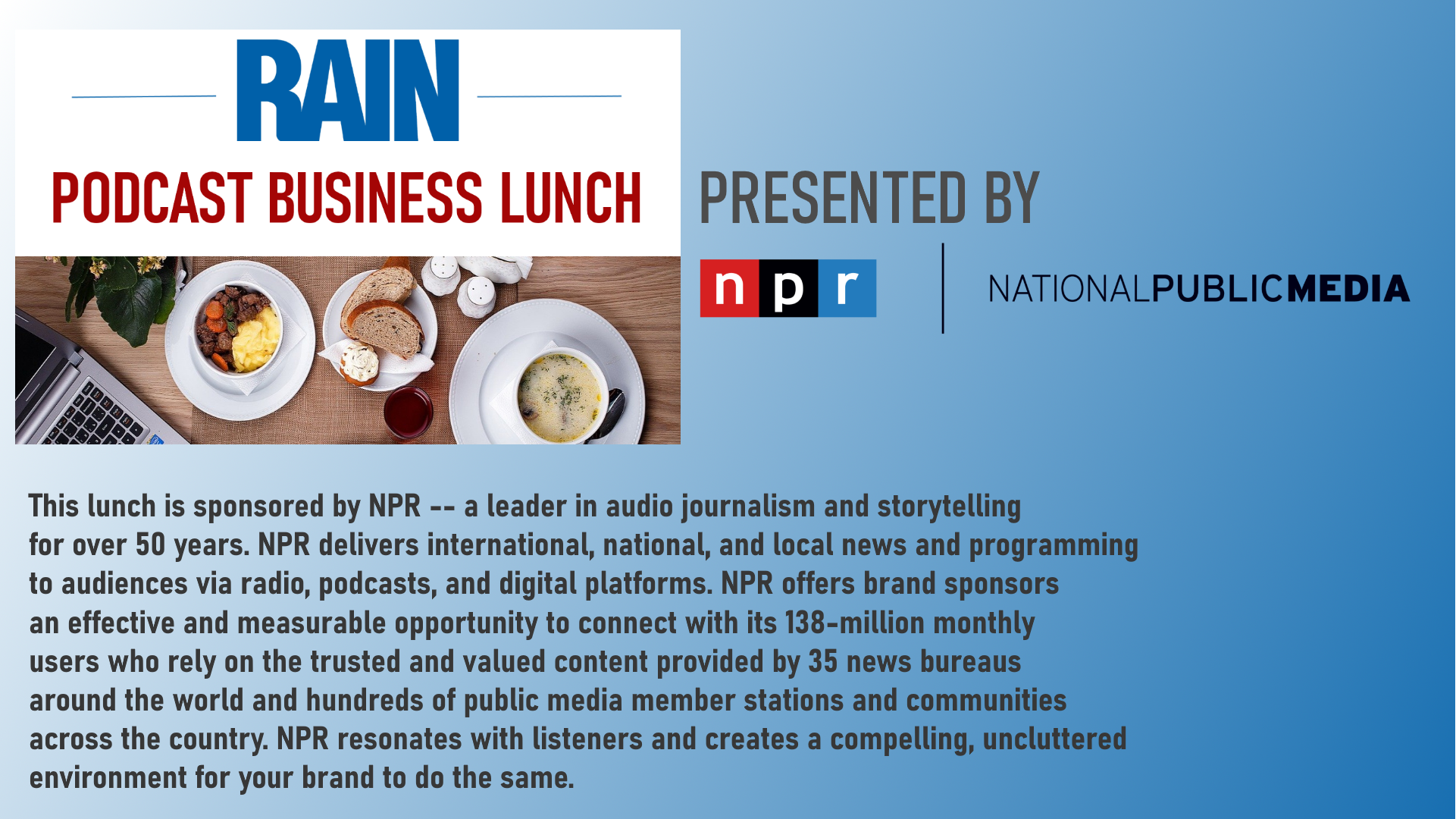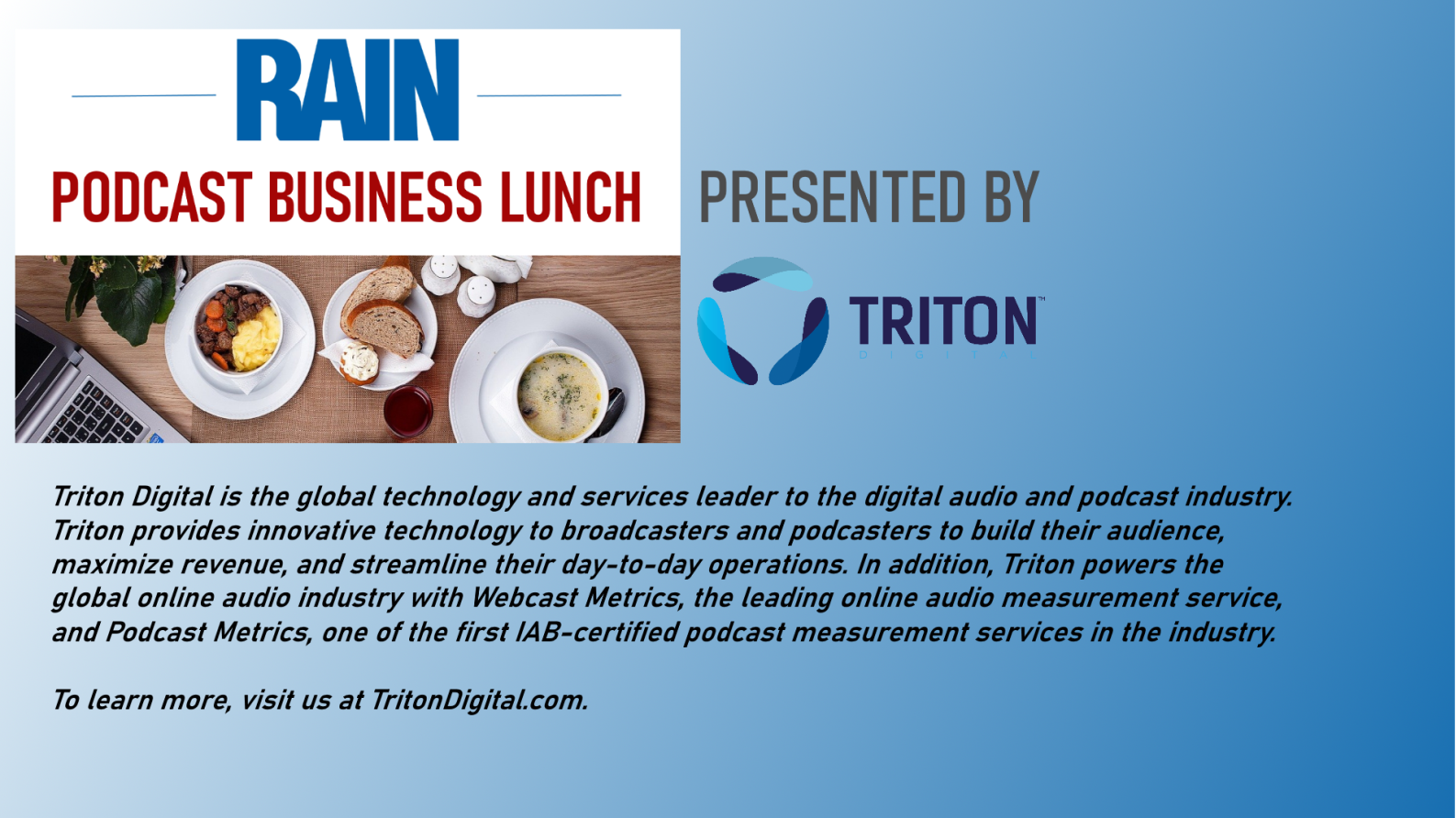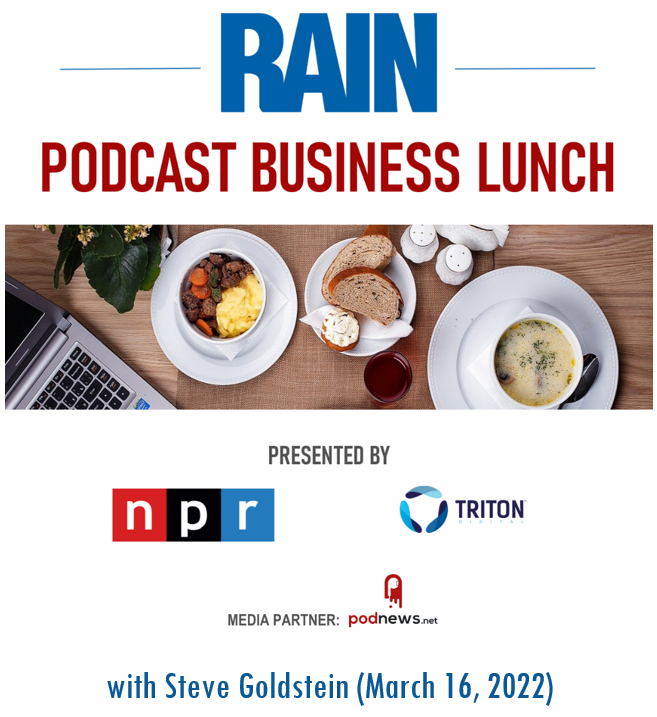
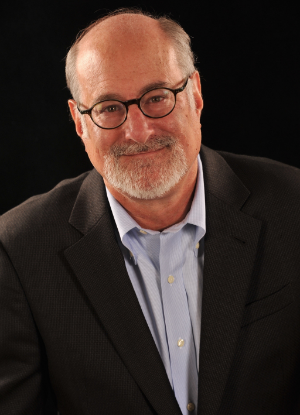 Brad: Steve, thanks so much for joining me today.
Brad: Steve, thanks so much for joining me today.
Steve: Happy to be here, thanks for asking.
Brad: You’re welcome. You’re the founder of Amplifi Media, a strategic advisement company that helps brands and other organizations start podcasts. And you founded Amplifi in 2015. So before we talk about your present-day work, let’s go back in time. You were enjoying a 30-plus-year career in radio as an executive and as a co-founder of a radio network and you decided to retire from that career and found a podcast startup. Take me back to that decision moment, if you would, and also tell me what podcast looked like to you then.
Steve: Yeah, it’s a really good question. And there was a seminal moment. I am watching House of Cards, which was released two years before I started Amplifi Media, and I’m thinking, “This is the on-demand arc that’s happening in TV right now, but it doesn’t appear to be happening in audio, and intuitively, you just have to know that it will be happening in audio.” And so it took me two years to work up to it, but I launched seven years ago, April, so next month, and it was also based on watching what I call my science projects. Today they are 32 and 30 and 23, and watching how they consumed media, and again, this is going back seven or nine years, it was really fascinating in terms of their choices and their choices were not linear even then.
Steve: And you asked me, what did podcasting look like? It didn’t look like much beyond public radio. I think public radio had spent 10 years at that point really making inroads and they were quite good at it, but that was on the public non-commercial side and nothing had happened on the commercial side, there was nothing that was just a bunch of small niche shows, some were high quality, but most of them were early stage podcasts.
Brad: How has radio done, in your opinion, since then, a lot of acquisition? Of course, we all know that, but in terms of content creation, has radio… Commercial US radio, what has it done?
Steve: Yeah, it’s a mixed bag, and it depends on the company too. You have the iHearts who have been very aggressive, Odyssey, very aggressive. But in general, I think you need to look at podcasting as a part of the digital build for radio stations. And today, after about 15 years of streaming, they’re at about 12% of their content being consumed digitally. Even during the pandemic, when the smart speaker became more of a thing, because there were these speakers all over the home and people were in their homes, that only boosted by a share or two, so you still don’t have a lot of digital listening. And I think there is this fear of where podcast fit into the ecosystem and I certainly don’t want to do the cliche, digital dimes versus dollars, but there are a lot of radio stations, when you have the conversation, they say, “How do I make money on Tuesday?” and it’s not going to happen that fast.
Steve: And so they have to be far more intentional about it. I was at the very first conference I’ve been to in months and months and months, very recently, it was the Barrett Sports Conference in New York, and my guest for a panel was Gordon Borrell, who tracks local media. And if you want to spit up your lunch, go watch a session with Gordon about how it’s going to change and his feeling is 10,000 radio stations in less than 10 years will be 5000 radio stations and that 80% of the dollars coming through the local market are now Google and Amazon and Facebook, and you’ve got all this competition from the TVs trying to hang in, newspapers which in many markets barely exist. The whole market has changed, but the driving force is going to be, going back to my science projects, how they consume content. And the median age for a sports radio station is 49. The median age for a news talk radio station is 56. How are you going to get the 30-year-olds in the fold unless you meet them where they are?
Brad: Okay. Well, let’s talk about your work with Amplifi. I don’t think you’ve worked with any radio networks on creating podcasts, but you certainly have worked with many brands. Do you consider Amplifi a branded podcast executive producer? Is that one way to look at it?
Steve: We’ve done some work in the branded sector. We co-produce with many consider the top branded podcasts out there. And sadly, I can’t tell you who it is because we have an NDA, but it is a monster. And then we are doing work for other companies like EY, Ernst & Young. I’ve done big ones, smaller ones. I’ve got a company called NCMIC, they’re the largest insurance company for chiropractors in the United States, they have 40,000 clients, and we work with them on creating their own branded podcast targeting their 40,000 clients. So there’s a lot of different ways at that. But I do work with radio companies which sort of goes back to your previous question…
Brad: I didn’t know that.
Steve: I’ve done work for Beasley, Hubbard, ABC News, NBC…
Brad: I know about ABC because of Start Here.
Steve: Yes, correct.
Brad: The morning show. Tell me one or two others specifically that you’ve done with radio.
Steve: So we worked with Beasley in getting their whole podcast platform going. I’ve done some work for Bonneville early stage, mostly KIRO in Seattle. We’ve done work with WTOP in Washington, Hubbard. So we’ve done some radio work.
Brad: You work with Dave Ramsey, I think, tell me if I’m right or wrong about that. And explain, assuming I’m right, explain what the work is.
Steve: So we work with the Ramsey organization, which is a huge organization. They have over 1,000 employees and they are just so smart. We work with them on all of their podcast and voice efforts. In addition of the Ramsey show may have seven other podcasts, and we work with all of them on growing the platform and trying to figure out how to maintain dominance, to move past their tribe, they have a significant tribe that introduce new people using new platforms. They are super smart and they are always on top of what’s next.
Brad: Would you say then that the work now is more about promotion and audience-building and reach than it is about production and conception of the programming?
Steve: No, I wouldn’t say that. I think a lot of the thinking going on in the organization is about innovating the content. So they have some legacy titles which do well, but they are not an organization that rests on their laurels. And so we spend a lot of time talking about building what’s next and what that looks like and it will not be like everything else that they’ve done.
Brad: Yeah, okay, that’s an interesting teaser.
Steve: But it’s also… It is super fun. When I think about my radio days, radio days, we built everything up, of course in the next year, out of necessity, had to take some of it apart. I used the analogy that you would go in the airplane and they would hand you a salad and then they would take away the green peppers, they take away the radishes, and then the next thing you know, they take away the salad. That’s the way it felt over on the radio side. On the podcast side, it’s all growth and innovation, and so they are trying to master the sector. So everything is about: What else can we do?
Brad: I’m interested in the conversation that happens when a brand approaches you or you approach a brand… Well which way is it? They must come to you.
Steve: Well, it’s both. It’s a lot of recommendations. Most of my business comes from referral.
Brad: Okay. So a brand comes to you and begins to have a conversation of, “We think we should have a branded podcast.” How does that conversation go? What are their expectations? What are their needs?
Steve: Yes, so I wrote about this in my blog that most branded podcasts will fail, and that’s because there is not enough thought placed into the process, there isn’t a content forecast, meaning what are you going to do after the first episode, there isn’t the ability to track an audience. I mean, there’s a lot of complexity. I think it’s the most difficult category in all of podcasting because I mean, let’s face it, most people, they don’t want to interact with brands. I don’t need a Coca-Cola podcast. So I think it’s got to be the right brand, it’s got to be the right content. There needs to be some kind of megaphone, some way to market it. So I think it’s a delicate balance. And so that’s why I think most branded podcasts won’t make it, but those that figure it out, and some do it with us and many do it with other companies, I mean the Pacific content people have been marvelous. It can be magical, but it’s not for everybody.
Brad: So a lot of prospective clients come to you with rudimentary conceptions of what they want to do, they just kind of want to be in the space, but don’t know how to be. Is that right?
Steve: Right. I think that’s exactly right.
Brad: Okay. So what do you say is… I mean do you have a kind of questioning protocol by which you can…
Steve: We do, we do.
Brad: Determine their needs and their KPIs and all that stuff? What happens next?
Steve: Yeah, yeah. I mean I’m a process guy. That is sort of what I did on the radio side is come in and we work the checklists and try and figure out what makes the most sense. And so I’ve certainly adopted that and it’s evolved on the podcast side. I have a 17-question process that we go through, and everybody thinks it’s going to take 20 minutes to go through it, and somewhere in that second or third hour, people realize there’s a lot more to it. I did publish a brief version of that on the blog, which has… It’s a synthesis of some of the questions, but it is a good starting block.
Brad: The blog, by the way, is called Blogstein. Do brands who come to you have unreasonable expectations, putting aside the basic fact that success at the start is an unreasonable expectation? Do they think that podcasting will have some kind of magical result for their business that is unrealistic?
Steve: Look, this is the new, new thing right now. Everybody is piling into podcasting, you see the announcements all the time. There are a ton of production companies. There’s a ton of talent. There’s big name Hollywood talent. There’s fiction podcasts. There’s everything. Everybody is trying to get in right now. And so brands of course, are interested in that. I have a client who came to us and said, “Look, we’ve been creating content on our website,” so we’ll call it a blog, but it’s been authority content, it’s been them talking about their knowledge in a category and using their people, and it’s really smart stuff, but the readership for that on the web has gone down dramatically. And so they came to us looking for another way to disseminate their authority and their interest and their information. And so they’re experimenting, and I’m going to use the term experimenting, but they’ve made a real solid commitment to trying to master the podcast space as another means to communicate with their constituency and potential clients.
Brad: Let’s take a look at the ABC work that you did. It’s the Start Here morning news podcast. I listen to it. And you are credited at the end of it every day, and… Were you then the executive producer of Start Here?
Steve: No. I was a consultant for a…
Brad: That’s a good clean answer.
Steve: Reboot team. At the time, Steve Jones was running ABC Audio, ABC Radio, and a really adventurous group who wanted to get in early and Daily from the New York Times was up and running and successful. And Up First from NPR was there. No one else was. And ABC has great authority in sport news. I mean, when you think about David Muir and World News Tonight and… But there was nobody in the big broadcast companies doing anything like this. And so they got the green light from ABC News, and I advised them through the whole process at the outside for about the first year, year and a half.
Brad: Oh, okay. So were you a part of creating the template for the show? It’s such a structured program, which I think is one key to success is decide on how the structure of the thing is going to go and then stick to it. Were you instrumental in forming that, the format for the show?
Steve: Yeah. Yeah, the architecture of the show, the whole scaffolding was a group process, but, yes.
Brad: Okay. I imagine that ABC didn’t necessarily need technical production support from you. I mean, they’re a broadcaster, but are there… There must be brand situations where the conversation includes, how do we do this technically? And do you get involved in that?
Steve: There’s far less of that conversation today and far more of the marketing conversation. And so I brought somebody in to work with me, Susie Schultz, because every conversation we had with a client starts with the content and immediately flips to the megaphone, how are we going to let people know about it? And one of the areas that we focus on is owned media, because a lot of these companies that we’ve worked with, they have assets. They have big web initiatives. They have an email, they have a lot of social, but they don’t necessarily use it well, or know how to use it well in surfacing podcast content, and so we spend quite a bit of time on that.
Brad: Okay. What’s the biggest mistake that brands do or can potentially make when they are starting a podcast?
Steve: The first thing that I think about is what the 10th episode is going to sound like. And I think that that becomes more of a rigorous process internally when you have to figure that out. The other thing I’ve noticed with branded clients, brand clients, is that they need to devote a lot of time internally to this. It can’t happen readily from the outside. It needs more than one point person. It needs integration internally, and so there needs to be that commitment. I would say that’s probably the biggest pain point, is that they have to learn a new language and they have to spend time with it.
Brad: And they have to devote more resources possibly than they expected to?
Steve: I would say almost universally that’s certain.
Brad: Do you have some potential clients then that fall away from the idea because it’s bigger than they thought?
Steve: Yeah. If you read that blog post about why branded podcast fail, again, I am a glass half empty guy on a lot of stuff.
Brad: Well, I speak to you and Tom Webster and Eric Newsom, and you all are resolute pessimists!
Steve: Oh, well, if you’re in the content into the business, you know you’re going to die. [laughter] It’s just a question of how fast can you prevent it? So you go to the doctor and you try and figure out so that you know.
Brad: [laughing] Oh my god.
Steve: But somebody said to me a long time ago, every day your cume is going down. So that’s a radio reference, but it’s true on the podcast side. Every day your audience is going down. Somebody decides they no longer want to listen to it, or they forgot to listen to it, or it’s sitting in the podcast queue, and people are listening to an average of five podcasts, and so you get bumped off the shelf. All of the time, and again, just substitute the name in the media here, TV, audio, newspaper, your cume is going down unless you do something about it.
Brad: Let’s talk about success stories with your clients. The companies that come in, receive your resolute pessimism, adjust to it, adapt to it, create a successful product that is good for them, what does that team say when they’re reporting upward about what a great success it was? What are the elements of that success?
Steve: It depends… First of all, I hope they say that. I hope they say that it was a success as opposed to, “Okay, contract’s up. Let’s get that guy out of here.” But I think that the big takeaway is linked to the mission, okay, and each client has a different mission, and I think that’s part of where we figure out what success looks like. Most podcasts are not going to have millions of downloads and listens. Hopefully, they have made impact in a particular sector. Hopefully, they’ve got more rigor. I’ve worked with a client on a travel podcast. Kind of tough to launch a travel podcast in the midst of a pandemic, but we wanted to be out there so that when travel started again, the name was available, the content was available and the host had experienced time in the cabin. So the initial phase was not about the downloads, it was about the proficiency. And now that travel is picking up, they are in a really good position to take advantage of luxury travel, which is what the niche is.
Brad: So in cases like that, it’s about connecting with consumers and brand awareness?
Steve: Or brand partnerships. One of the things that I am finding is that unless you have gobs of money and the owned media that we talked about is you may need a partner, and I don’t think there’s anything wrong with that, and in fact, I think there’s a lot that’s right with these synergistic relationships that are coming about with companies joining together, somebody is good at producing content, somebody else is good at distributing content.
Brad: Tell me about the 10-second rule, which I love. Tell me about it anyway.
Steve: So most people are making choices about content pretty rapidly. Do you ever punch up a sitcom on TV and you know, in just a few seconds, whether that thing is any good or not? Sure, there are some shows where it takes a while, you need to get through an episode or two. I remember, Schitt’s Creek, people said you gotta get three episodes in before you figure it out. But most people don’t have that kind of attention span or interest for something. In the early days of podcasting, there was a lot of, “Hey, what did you have for breakfast today?” Kind of openings to the shows–
Brad: The early days? I still hear too much of that!
Steve: –still hear too much of that. Let’s get to it! Let’s not waste people’s time. And they are very narcissistic about their time as they should be, and they will stop the podcast, they’ll stop the video. Why is TikTok so successful? Because the deal is you’re going into it knowing it’s going to be brief, and there’s something brilliant about that in this day and age. Too bad for the Quibi guys, but TikTok is Quibi, isn’t it?
Brad: For me, it’s really a five-second rule. The first five seconds determine whether I’m going to listen to the next five seconds, and then if I like it, I’m in.
Steve: Yeah, we used to run those teases up in front of a podcast where we take a clip out of the podcast and throw it up there thinking, “Oh, that’ll hook ’em.” But those teases often took 20, 25 seconds, and they didn’t do a good job in hooking. Way better to get the host to go in right away and talk about the benefit of listening to the podcast right now, what you’re going to get off of this episode.
Brad: Well, I wonder what you think, even though this might take us away from your business particularly, but what do you think about opening with a block of pre-rolls?
Steve: So there are many podcasts who can do that and that’s because they built a significant constituency and good for them. I would hope that every podcast I work with could get to that point, but I do think that’s rarefied there.
Brad: Are many of the podcasts you help to create ad supported? Do they run ads or is that really not the point in a lot of branded podcasts for example?
Steve: Well, on the branded side, certainly not. On the commercial side, we do plenty of work in the commercial sector, and yes, of course. So it does come down to ads, and I love that there are choices and ads, that we have moved beyond that baked in live read, which is terrific, but that’s not the right thing for every client, and some of them… And I think about this like Network Radio, some of them are never going to aggregate a big enough audience to command that live read. So maybe they need advertising coming in in different forms, and that’s where these aggregators, these networks are going to be really powerful, and you see them building the fortification. They are going to be able to to serve ads, not to the 1% of podcasts that can be sold and have massive audience, but to the other 95%, 96%, 97% of podcasts that are going to need some automated fashion. And so I think about it like Network Radio, where they would take a pile of sport shows and put them together, or a pile of classic rock shows, or female targeted shows to make a network out of them. I think we’re going to see the same thing. I think we are seeing the same thing in podcasts.
Brad: Steve, I am an avid reader of your blog, Blogstein, as everybody should be. Tell me about the Grid of Pain that you once wrote about.
Steve: Oh yes, the Grid of Pain. That was borrowed from David Lebow and Jimmy De Castro who ran a company called AMFM for a period of time, and they created the Grid of Pain, and I revised it for podcasting. And essentially, you want to be in the upper right hand corner, which is the high awareness corner and a high value content.
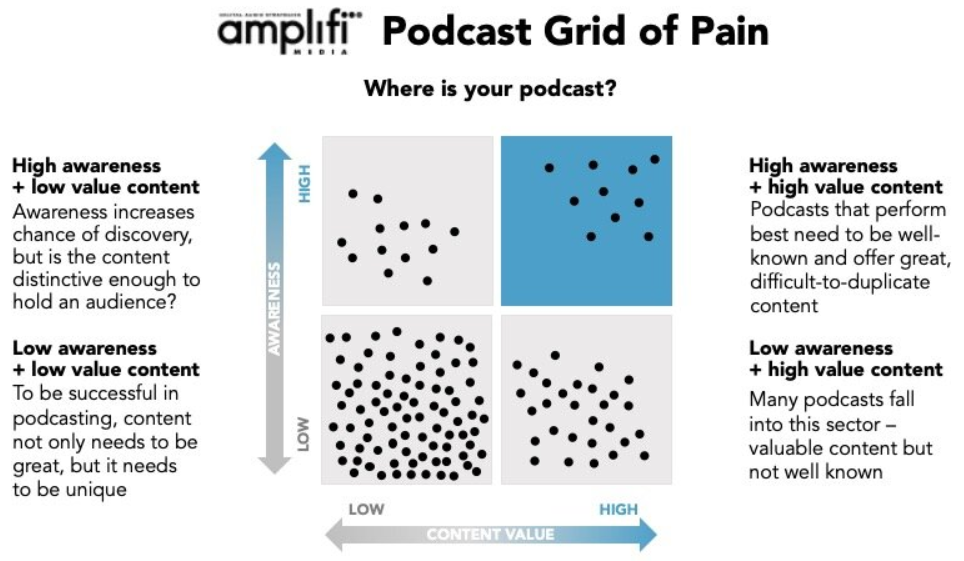
Brad: It’s kind of like a SWOT chart, isn’t it?
Steve: Yeah, but it’s a little bit of a Rorschach chart because most of the dots are going to be in the bottom left sector, which is low awareness and low-value content. There’s a lot of low value content out there, and they’re going to have a tough time, in an environment in which there are so many pieces of content competing for time, and then I’m not just talking about podcast content. I’m talking about all content, that anything that is low value and low awareness is going to get throttled. It’s just going to have a hard time surviving. So that’s why it’s the Grid of Pain. It’s hard to get from the bottom left to the upper right or I think it’s the other way depending on where the camera is.
Brad: That’s right. Who knows what Zoom is going to do to that? [chuckle]
Steve: Yeah, but it is… That is the hardest part. And by the way, the proof on all of that is if you go look at the either Podcast Index or Daniel J. Lewis’ site, 80%, eight out of 10 podcasts are inactive. They’re gone for whatever reason, and there are a variety of reasons. That could be a limited series, that could have been some guys in the dorm room trying it out during the pandemic. There are a lot of reasons, but 80% of the podcasts have not produced anything in at least 90 days and more than a year.
Brad: Yeah, I was going to bring that back.
Steve: So we are back to that Grid of Pain.
Brad: Right, I was going to mention that because that was a subject of one of your blog posts as well, that there aren’t really millions of podcasts. I don’t remember the number you arrived at, but maybe you do. Could you talk about that? You have a little bit, but just continue that thought. What is the universe of podcasts really?
Steve: Yeah. And so that’s a moving number. So I wrote that post over a year ago, so I don’t know what the new number is. I do know that 200,000 podcasts have been produced in the last seven days, that’s it, out of that 2.5 million or whatever the number is. And it really depends on… There are different numbers in different places.
Brad: Let me clarify that for my own mind. You mean 200,000 podcast episodes have dropped?
Steve: Yes, correct.
Brad: Okay, so the universe of podcasts… Well, we don’t have a number is what we’re saying. We don’t really know how many podcasts titles are active in the market.
Steve: Yeah. It’s a moving number. I will say that there was a flood of introductions during the pandemic as people were sitting around trying to futz around with this stuff, because the barrier to entry is quite low, and there’s something wonderful about that, but the barrier to developing audience and being able to keep up the content, that’s a different threshold, but it is a way smaller number than most people think, and I remember working through the numbers and I actually tried them out with my friend, Pierre Bouvard, over at Westwood One and Pierre said, “This is the greatest number I’ve ever seen in all of podcasting.” I go, “Yeah, but I’m tearing apart the industry here by narrowing the number.” He says, “No, no, no, no, you have it wrong. The advertisers are overwhelmed by choice, and what you’re saying is, there’s far less choice, and that makes it a lot easier for them to get their arms around.” So there’s another perspective, which was quite true, is quite true, and you see the growth in podcast spending with brands.
Brad: Yeah, how interesting. Also, you can go to Listen Notes to see the pace of podcast creation, and you can see the COVID effect. Spike, spike for two years and now beginning to fall off the cliff.
Steve: Right. Still, a lot of content out there, and as I mentioned, the barrier to entry is low, so there’s a lot of experimentation, but if you look at the number of podcasts that stopped producing and then you figure out why, sure, most of them are going to be about finding an audience or finding a monetization model.
Brad: Sure, yeah, or even just the effort of making it every week. Easy to experiment, hard to follow through.
Steve: Yeah, and I am the only American without a podcast, I just would like to say that for the record.
Brad: What a fine distinction. Outstanding. [chuckle] Now, this might take you off your track a bit, but let’s talk about subscriptions. What is your thought about what… I guess we can call it kind of a Renaissance, thanks to Apple’s launch of their subscription product. My main question to you is, even as it seems to take off initially, is there real consumer value?
Steve: Yeah, I think it’s a great question. It’s somewhat of an unanswerable question because we’re, I don’t know, first inning, second inning. I do think that the barrier is difficult. I sort of look to the NPR people, because if anybody is gonna be able to figure it out, it’s that crew because they have a model in which they’ve asked people for money for years and years…
Brad: Good point.
Steve: But they never asked the podcast listeners.
[laughter]
Steve: So, I do think they have a, pardon the pun, a drive that no one else has, but I don’t think the numbers are big, and I don’t think they’re going to be big. I think it’s too early. But I also think you have to think about people’s wallets, and we’re overwhelmed with streaming services, and you see the drop-off rate, the renewal rate on a lot of the streaming services. How many do you need? Netflix, Disney Plus, Paramount. There’s so many of them, and it’s costing a lot of money, but we in subscription have to fit into that ecosystem too as people plunk down their MasterCards.
Brad: Yeah, good point. Well, Steve, it’s a great pleasure to talk to you. Thank you for making time to do this.
Steve: Thank you for asking.
.

